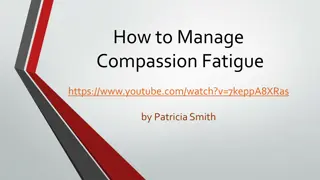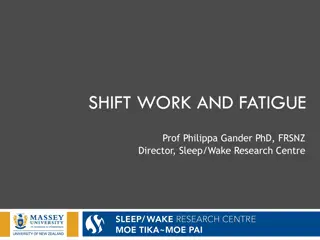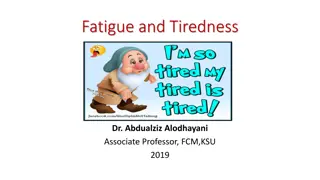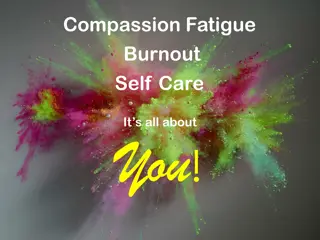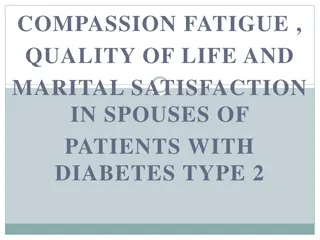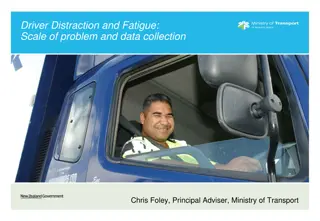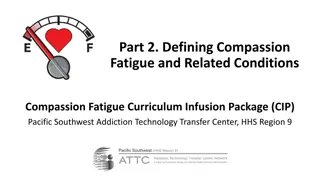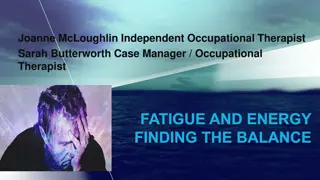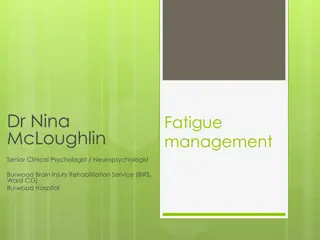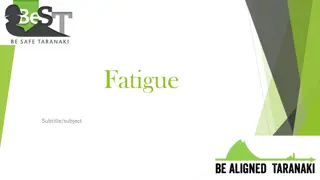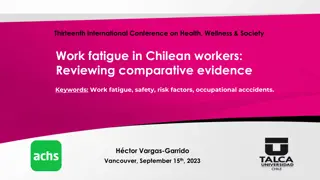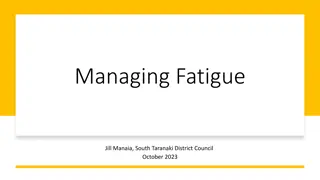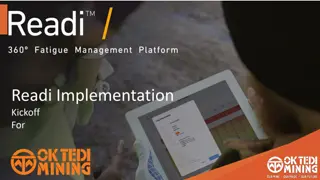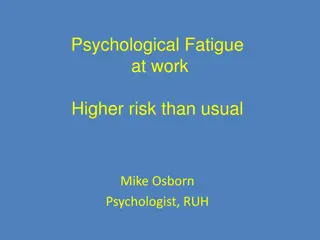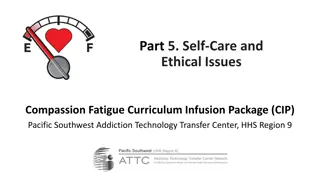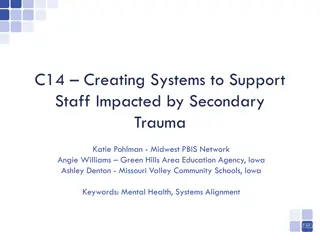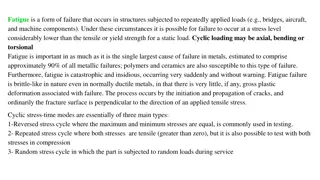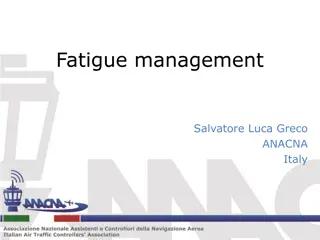Understanding and Addressing Compassion Fatigue in Helping Professions
Explore the challenges faced by helping professionals like moral distress, vicarious trauma, burnout, and compassion fatigue. Learn about self-care strategies, awareness, and resilience to prevent burnout and maintain well-being in demanding roles. The presentation emphasizes the importance of recognizing and addressing the emotional toll of caring for others.
Download Presentation

Please find below an Image/Link to download the presentation.
The content on the website is provided AS IS for your information and personal use only. It may not be sold, licensed, or shared on other websites without obtaining consent from the author. Download presentation by click this link. If you encounter any issues during the download, it is possible that the publisher has removed the file from their server.
E N D
Presentation Transcript
Managing Compassion Fatigue, Vicarious Trauma and Burnout in the CIT Responder Michelle S. Albert, LPC, CSOTP Jail Diversion Supervisor Alexandria CSB Andrea Shea, LPC Emergency Services Supervisor Prince William CSB Virginia CIT Conference October 16, 2018
Exercise: Life / Work Balance Were the areas in which you score high what you predicted they would be? Are there things in your life draining you that you didn t suspect or realize? When is the last time you gave careful thought to specific things that drain you? Do you engage in healthy self-care practices? Do you practice self-validated caregiving? Is your self-care guilt-free?
The expectation that we can be immersed in suffering and loss daily and not be touched by it is as unrealistic as expecting to be able to walk through water without getting wet. Kitchen Table Wisdom (1996) Rachel Naomi Remen
Objectives Develop a framework for understanding and differentiating between: Moral Distress Vicarious Trauma Burnout Compassion Fatigue Normalize the helper experience Self-Assessment / Awareness Self-Care and Resilience Strategies Have Fun!
First World Problems https://www.youtube.com/watch?v=vN2WzQzxuoA
The Reality of Helping Professions Compromised or inflexible systems (i.e. schedules, lack of staff, lack of training, poor work space/environment) Systemic challenges and budget cuts Difficult stories and situations of those you help Losses Disclaimer own experiences
Moral Distress An issue that affects all helping professions Involves a threat to one s moral integrity that sense of wholeness and self-worth that comes from having clearly defined values that are congruent with one s perceptions and actions A Helper may experience Moral Distress or Moral Injury multiple times per day or shift When policies or routines conflict with beliefs about patient care (Mitchell 2000)
Trauma Primary trauma A trauma experienced in the first- person. Professional or personal - Many people in the helping profession have experienced multiple personal traumas. It s part of what makes us good at our jobs! Secondary or Vicarious Trauma A trauma that is experienced second-hand, in the re-telling of events, investigations, observations Tertiary Trauma Long-range effects of a traumatic incident or pervasive environmental conditions Which of these three is most damaging?
Vicarious Trauma (VT) Occurs when the stories we hear from people transfer onto us in a way where we are secondarily traumatized and have difficulty ridding ourselves of the images and experiences they have shared The profound shift Helpers experience in their world view when they work with people who have experienced trauma Fundamental beliefs about the world are altered and possibly damaged by being repeatedly exposed to traumatic material
Burnout Does not mean our world view has been changed Gradual onset of dissatisfaction and resentment with the work environment The exhaustion and disconnect employees can experience when job satisfaction is low and they feel powerless and overwhelmed Directly related to the work environment hours, supervisors, training, etc. Depleted ability to cope with work demands Feel powerless to achieve goals Specific to the work environment, Burnout is the easiest to fix
Compassion Fatigue (CF) Characterized by an emotional and physical exhaustion, a Helper can develop CF over the course of their career when they are unable to refuel and regenerate A deep erosion of our compassion and our ability to tolerate the strong emotions and difficult stories of those with whom we work Stems from absorbing the suffering of others (Figley, 2009)
Risk Factors Intensity Frequency Severity Proximity Personal Factors Previous trauma Anxiety Depression Impulsive/High-risk behaviors Substance use
Where are your Skittles? Have you noticed a change in your world view or have you found that you give the best of yourself at work and have nothing left when you get home?
Physical Symptoms Shock / Disbelief Sweating Rapid heartbeat Unexplained aches and pains Dizziness Impaired immune system Restlessness Sleep disturbance Appetite disturbance
Impact on Professional Functioning Performance Decrease in quality and quantity Avoidance of job tasks Setting perfectionist standards Low motivation Increased mistakes Obsessing about details Morale Decrease in confidence Dissatisfaction Apathy Detachment Loss of interest Negative attitude Lack of appreciation Feelings of incompleteness Interpersonal Withdrawal from colleagues Decrease in quality of relationships Staff conflicts Impatience Poor communication
Impact on Personal Functioning Withdrawal from others Decreased interest in intimacy Mistrust Intolerance Loneliness Projection of anger or blame Irritability
Spiritual Symptoms of Poor Self Care Questioning the meaning of life Loss of purpose Lack of self-satisfaction Pervasive hopelessness Angry at higher power Questioning prior beliefs
Protective Factors Support system Part-time work or other tasks Adequate training Work-Life balance Belief system Current coping strategies Implementation of self-care techniques Ability to recognize warning signs
My Colleagues are Awful! Many Helpers find the negativity of their colleagues to be a big challenge Reframe this negativity and think of it as an organizational form of compassion fatigue, caused by the CF and VT that some of our most depleted colleagues are experiencing
What Does Your Dragon Look Like? Danger Caution Health Warning
Key Elements in Review CF/VT can affect an individual or can contaminate an entire workplace as a whole Not all workplaces are created equal! You could be experiencing burnout due to an unsupportive workplace in addition to CF/VT from the challenging work you do
Well, Thats Lovely. Now What? Awareness is the first step What is affecting you CF? VT? Burnout? Moral Distress? A combination of two or more? Understand your warning signs What are your Big Three ?
ABCs of Prevention and Maintenance Awareness Recognizing signs and symptoms Balance Taking personal responsibility Connection Seeking consultation and debriefing
Have you been slimed? Debriefing vs. Venting aka sliming Self-Awareness Pay attention to how your sharing impacts others; avoid sliming Permission to come aboard Fair warning
Get Control of Yourself BREATHE!!! Identify the desired outcome Steps for a desired outcome: Ask yourself what you want Identify areas in your life where you DO have control Make a plan: What s in your Self Care First Aid Kit? (Your person , snacks, stress ball, comedy, music, exercise, etc.)
4 Domains of Control to Make a Change Physical Cognitive / Attitude Existential / Meaning & Purpose Relationships No is not a four-letter word
When to Seek Outside Help An increase in self-destructive or high-risk behaviors (alcohol, food, drugs/medications, spending, etc.) Missing work Increased irritability Lack of empathy towards everyone Anxiety Symptoms of depression Sleep and/or appetite disturbance Withdrawing Anhedonia/Apathy
Healthy Detachment What are you in this for? Are you making it about you? Are you wanting helping someone else to provide you with a sense of satisfaction? (e.g. You re OK then I m OK ) It doesn t mean we don t care. It means we learn to love, care and be involved without going crazy. (M. Beattie, 1992) When we allow people to be who they are, then we stop trying to change things we can t. (M. Beattie, 1992)
Stress Reduction Activity BANG HEAD HERE Directions 1. Place on firm, flat surface 2. Follow directions on circle 3. Repeat step 2 as necessary or until unconscious 4. If unconscious, cease stress reduction activity
Guided Meditation https://vimeo.com/132790897
I did the best I could with the light I had to see by - Author Unknown http://vignette2.wikia.nocookie.net/survivorsdogs/images/4/4f/Lighthouse.jpg/revision/latest?cb=20140730131304


